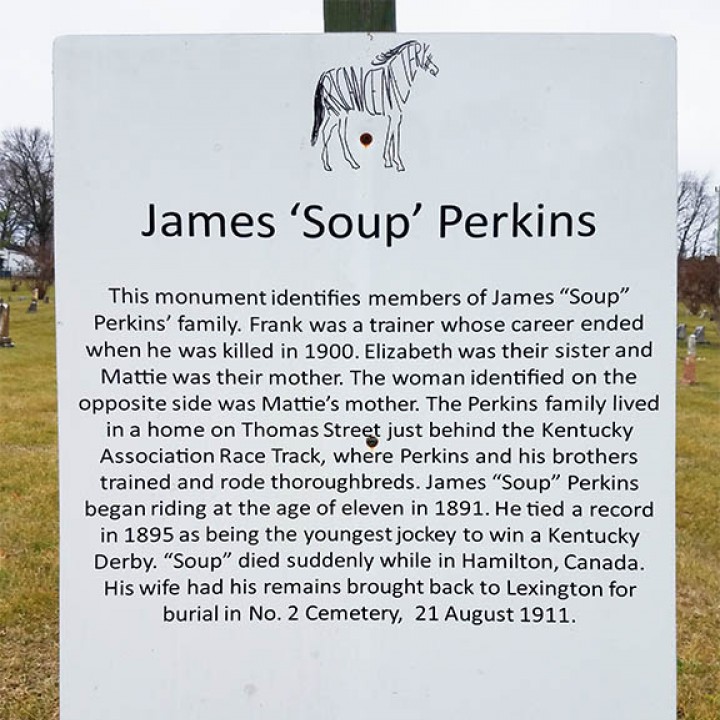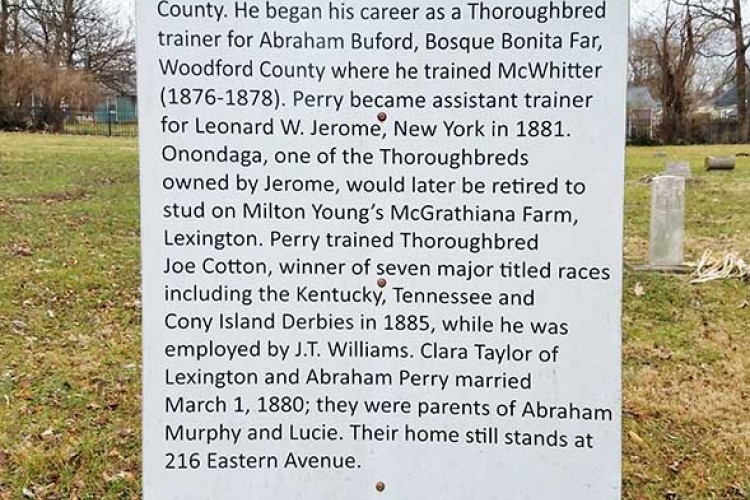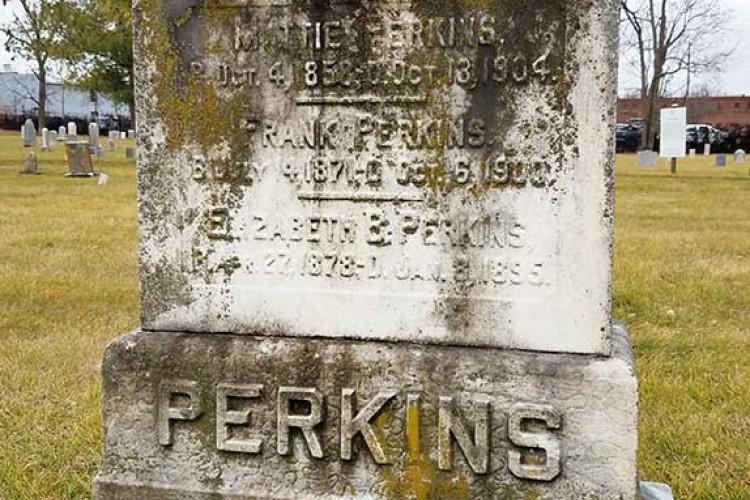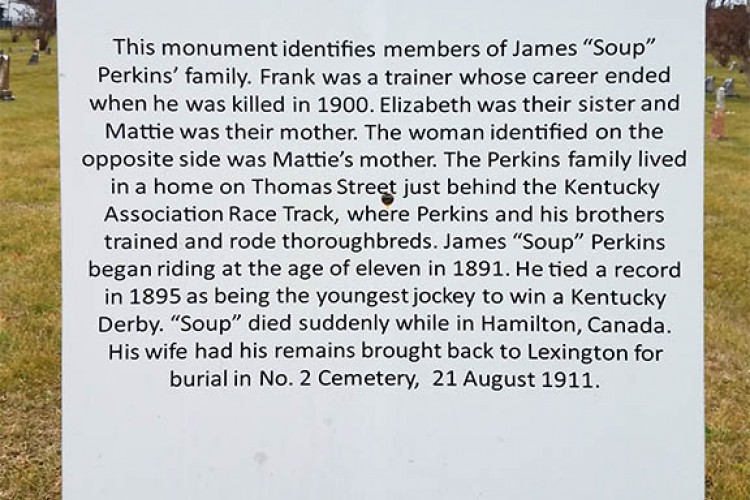
James Perkins
Childhood and Family
James Perkins was born in April of 1880. His parents were John and Mattie Perkins of Fayette County, Kentucky.1 His father John was a trotting horse hostler. His brothers Frank and William were both jockeys and later trainers.2
The Perkins children also included two more sons, Edward and Walter, and two daughters, Carrie and Elizabeth. Perkins began working with horses when he was ten years old due to his father’s and brothers’ influence. He received the nickname “Soup” because it was his preferred meal to eat while training to keep his weight down.3
In 1899, Perkins married Elanora “Frankie” Saunders in Lexington, Kentucky. They lived on Wilson Street.4
Career Beginnings
In 1893, at thirteen years old, Perkins made his first appearance as a jockey at the Kentucky Association track. He won five of the six races he rode in that day and placed second in the sixth race. Out of the twenty-six starts in his first season, he placed first sixteen times. In 1895, Perkins rode for Byron McClelland, a prominent owner-trainer based in Lexington.5
Career Highlights
In 1895, Perkins became the second-youngest jockey to win the Kentucky Derby. Riding Halma, they broke early from the field and won by five lengths for an exciting victory. That same year, Perkins won the Phoenix Stakes, also aboard Halma.6
Later Career
Like many jockeys, Perkins struggled to maintain the low weight required by the sport. He made a career change around 1899 to become a horse trainer and owner. He still jockeyed a race in 1902.7 One of his horses, Harting, was quite successful in meets at the Latonia Race Course.8
Death and Legacy
Perkins’s training career brought him to Hamilton, Ontario. He passed away there due to heart disease in 1911.9 He was survived by his wife, his father, and three of his siblings. Perkins was buried in the family plot at Lexington, Kentucky's African Cemetery Number Two though his name was not added to the marker.10 The alley next to his childhood home on North Upper Street in Lexington, Kentucky is named Soup Perkins Alley in his honor.
Sources
“1880 United States Federal Census.” 1880. Census. Fayette County, Kentucky.
“1910 United States Federal Census.” 1910. Fayette County, Kentucky.
Bay City Times. 1902. “Perkins Weighs 115 Pounds, Will Race at Newport.,” December 20, 1902.
Buck, H.A. 1899. Horses in Training. 571 Fifth Ave., New York: H.A. Buck & Co., The Technical Press.
Daily Racing Form. 1907. “Overweight Riders at Latonia,” November 8, 1907. Keeneland Library. https://drf.uky.edu/catalog/1900s/drf1907110801/drf1907110801_1_7.
———. 1927. “Will Perkins Succumbs,” April 19, 1927.
Fayette County Clerk. 1899. “Marriage Record of James Perkins and Elanora Saunders.” Book 10, 155. Colored Marriage Records.
Giles, Yvonne. 2009. Stilled Voices Yet Speak: A History of African American Cemeteries in Lexington and Fayette County, Kentucky. Self-Published.
Goodwin Brothers Firm. 1894. Goodwin’s Official Annual Turf Guide. New York, NY.
“Halma Wins the Kentucky Derby with African American Jockey.” n.d. Digital Scholarship Lab at the University of Richmond. The History Engine. https://historyengine.richmond.edu/episodes/view/281.
Indianapolis Freeman. 1899. “Marriage of James Perkins and Elanora Saunders,” April 1, 1899.
James C Claypool. 1997. The Tradition Continues: The Story of Old Latonia, Latonia and Turfway Racecourses. T.I. Hayes Pub., Co.
Lexington Daily Transcript. 1893. “A Short Sketch of Jockey Perkins,” October 22, 1893.
Lexington Herald. 1896. “Handsome Home,” February 15, 1896.
Lexington Leader. 1900. “Shot Down in His Own Door: Frank Perkins, a Negro Horse Trainer,” August 17, 1900.
———. 1911. “Perkins Body Here,” August 20, 1911.
———. 1927. “Will Perkins, Race Horse Man, Dies,” April 18, 1927.
“Perkins, James ‘Soup’ (Jockey).” n.d. In Notable Kentucky African Americans Database. Accessed February 12, 2020. http://nkaa.uky.edu/nkaa/items/show/669.
Philadelphia Inquirer. n.d. “They’re Off at Newport, Opening of the New Independent Track Is Very Successful.”
Rees, Jennie. 2015. “Derby Countdown Halma, 1895.” The Courier-Journal, April 11, 2015, sec. Sports. https://www.courier-journal.com/story/sports/horses/triple/derby/2015/04/11/countdown-kentucky-derby-halma/25594293/.
Weeks, Lyman Horace. 1898. The American Turf: An Historical Account of Racing in the United States, with Biographical Sketches of Turf Celebrities. 1898. New York: The Historical Company.
Citation
When citing this article as a source in Chicago Manual of Style use this format: Last name, first name of Author. Chronicle of African Americans in the Horse Industry. n.d. “Title of Profile or Story.” International Museum of the Horse. Accessed date. URL of page cited.
- 1“1880 United States Federal Census.”
- 2“Shot Down in His Own Door: Frank Perkins, a Negro Horse Trainer.”
- 3Rees, “Derby Countdown Halma, 1895.”
- 4Fayette County Clerk, “Marriage Record of James Perkins and Elanora Saunders.”
- 5Rees.
- 6“Halma Wins the Kentucky Derby with African American Jockey.”
- 7“Perkins Weighs 115 Pounds, Will Race at Newport.”; “They’re Off at Newport, Opening of the New Independent Track Is Very Successful.”
- 8“Overweight Riders at Latonia.”
- 9“Perkins, James ‘Soup’ (Jockey).”
- 10“Perkins Body Here.”








